Nuts & seeds are often taboo on a low oxalate, kidney stone friendly diet. This is probably because nuts and seeds are notorious for being high in oxalate. But, there are huge differences in oxalate between different nuts and seeds. If done correctly, nuts and seeds can be a part of a healthy low oxalate diet!
*Please note that this post contains clearly identified affiliate links. If you click on these links and choose to make a purchase, I may receive a commission (at no cost to you). As an Amazon Associate I earn from qualifying purchases.
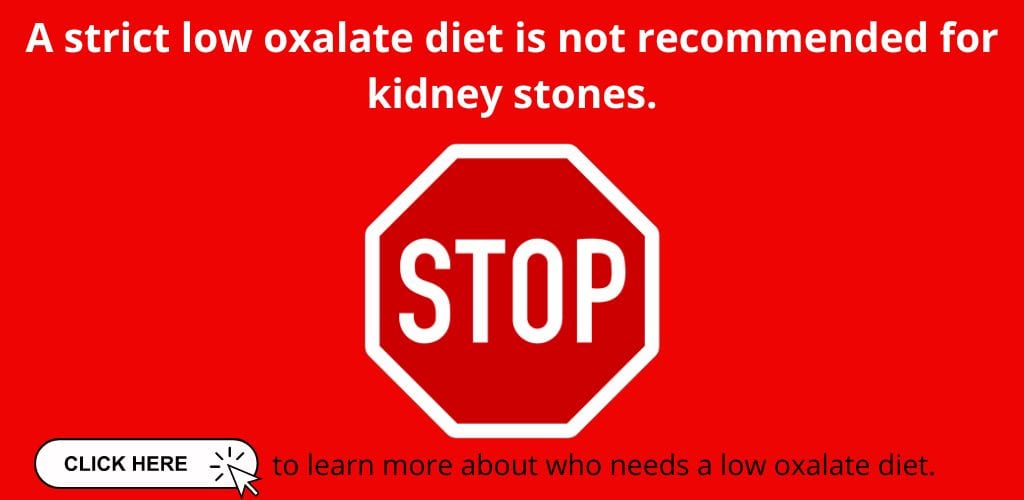
Table of Contents
Who Needs Low Oxalate Nuts?
Before we jump into which nuts and seeds are low in oxalate, it is important to know who needs to avoid high oxalate nuts and seeds.
Oxalate is most known for it’s role in kidney stones. However, not everyone with kidney stones needs to avoid oxalate. It is important to work with your doctor to figure out what kind of kidney stones you have. If you have a kidney stone other than calcium oxalate, avoiding oxalate will not reduce your risk of kidney stones.
If you were not able to have your kidney stone analyzed, a 24-hour urine test will tell you what kind of stones you are most likely to make. The test will also tell you what your kidney stone urine risk factors are.
Even for the same kind of kidney stone, urine risk factors can be different. For example, too much calcium in urine is the most common risk factor for calcium oxalate kidney stones. Other urine risk factors are high urine oxalate, low urine pH, low urine citrate and high urine uric acid. (1) You can target your specific risk factors with nutrition!
If you have high urine oxalate, it is important to follow a low oxalate diet, including low oxalate nuts. (2)
Remember that fluid, sodium, protein, calcium and healthy diet patterns all play very important roles in kidney stone prevention too! (1)
Why Eat Low Oxalate Nuts & Seeds?
Heart Health
Perhaps the biggest benefit of nuts and seeds is heart health! Nuts and seeds are a great source of heart healthy polyunsaturated, omega-3 and omega-6 fats. People who eat more nuts are less likely to have heart disease and high cholesterol. (3)
Fiber
Low oxalate nuts and seeds can be an important source of fiber. Eating enough fiber can be tough! Especially on a strict low oxalate diet. Adding healthy low oxalate nuts and seeds to your diet will help you get enough fiber. Women should eat 25 grams of fiber each day. Men should aim for 38 grams. (4) One ounce of pecans has about 3 grams of fiber. (5)
Fiber is most known for its benefit for bowel health. Eating enough fiber keeps you regular! Fiber can also help ward off heart disease and diabetes. (6)
Healthy Plant Protein
“Plant based” eating has become quite trendy in recent years – for good reason! Eating more plants like vegetables, fruits, whole grains, nuts and seeds is protective against chronic disease.
In light of the “plant based” movement, products such as Beyond Burger and Impossible Burger have taken off. Although these meat substitutes can be a healthy option on occasion, they tend to be very high in salt. If you have Chronic Kidney Disease, phosphorus additives may also be a concern.
If you are trying to cut back on meat, it is better to get protein from natural sources, such as whole grains, nuts, seeds, beans and lentils. Low oxalate nuts and seeds are a great source of plant based protein!
Brain Health
Nuts may also help protect your brain! Nuts are an important part of a Mediterranean diet pattern, which is associated with slower cognitive decline and reduced risk of Alzheimer’s disease. (7) In fact, nuts are a critical part of the “MIND” diet, which was created to target cognitive function and to prevent Alzheimer’s. The “MIND” diet has been proven to do just that! (8)
Low Oxalate Nuts
Coconut
0mg oxalate per ounce
Coconut comes in at the lowest oxalate amount – zero! However, the fat in coconut is not ideal. Coconut is very high in saturated fat, which is associated with worse heart health and is not endorsed by the American Heart Association.(9) Also, be careful of extra sugar in shredded coconut and coconut milk.
However, coconut is a great source of fiber! Enjoy coconut in smaller amounts and mix in other low oxalate nuts to keep your heart healthy!
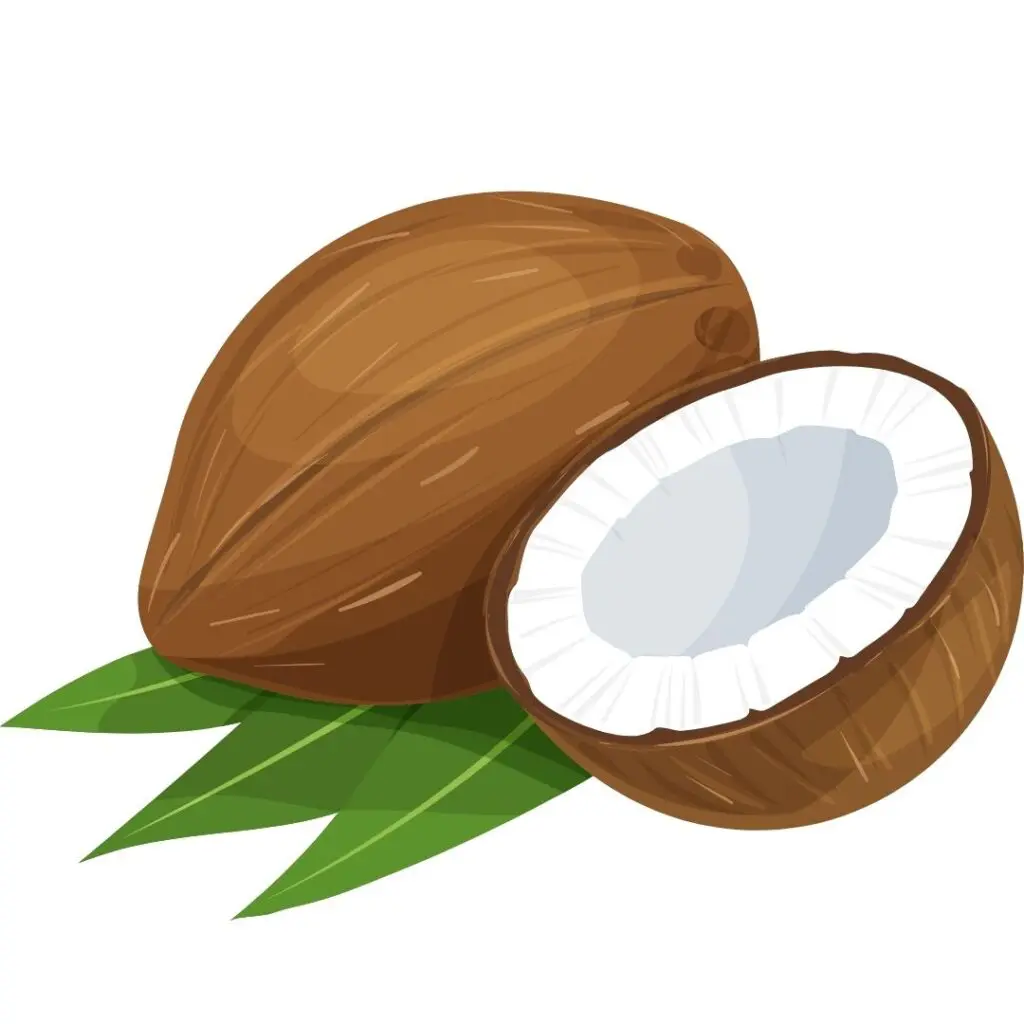
Macadamia Nuts
12mg oxalate per ounce
Macadamia nuts* are delicious in more than cookies! Macadamia nuts are a great low oxalate nut choice.
Pecans
10mg oxalate per ounce
Who doesn’t love pecans!? Sprinkle some pecans* on your salad or in oatmeal to add some fiber and healthy plant protein.
Pistachios
14mg oxalate per ounce
The perfect snack! Pistachios* are a great option for a low oxalate diet. They also happen to be one of the lowest calorie nuts.
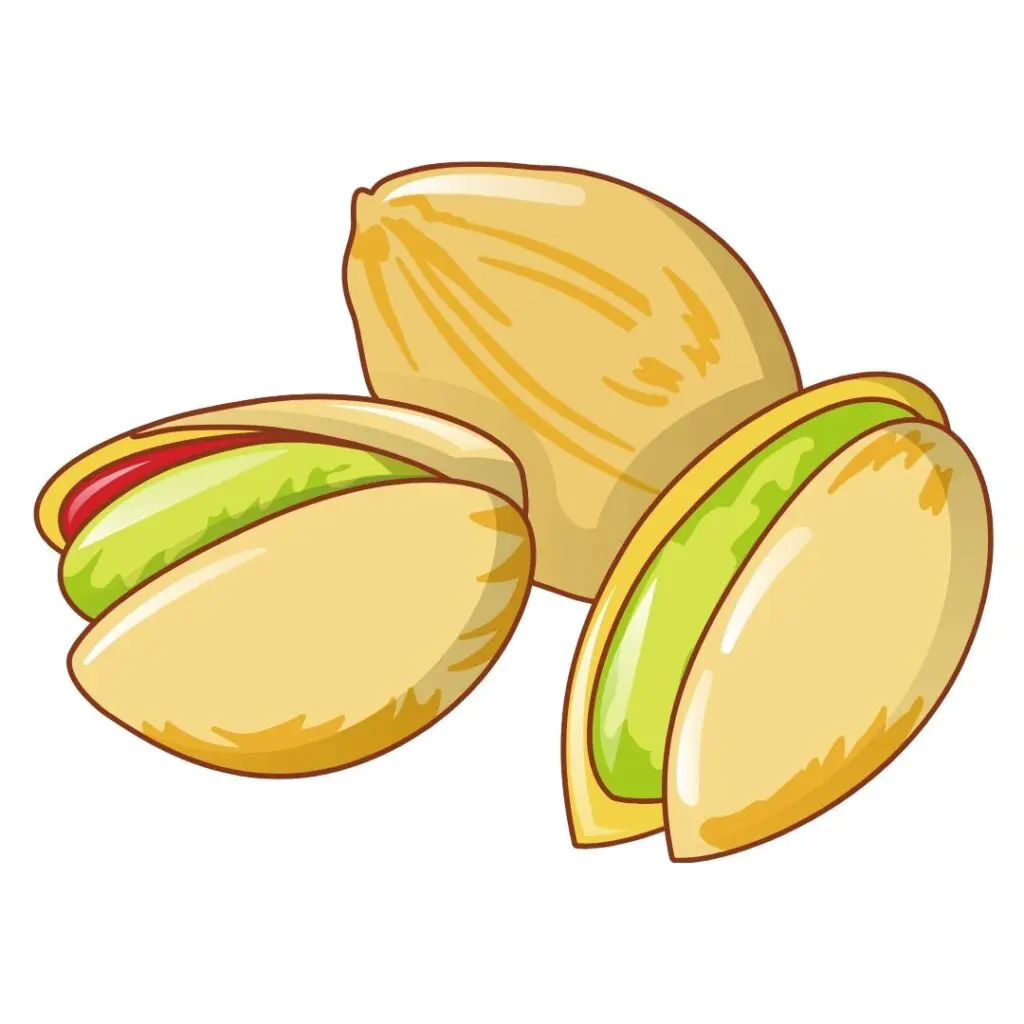
Walnuts
8mg oxalate per ounce
Walnuts* are packed with heart healthy polyunsaturated fat, making them a great option for your heart!
Low Oxalate Seeds
Flax Seeds
2mg oxalate per 2 tablespoons, ground
Flax seeds* pack 2 grams of fiber per tablespoon. They are also a good source of heart healthy omega-3 fats. Make sure to use ground flax seed, to be able to take full advantage of their benefits!
If you really like flax seeds, try Flackers*, a low oxalate cracker made from just flax seed, spices and a little salt!
Hemp seeds
3mg oxalate per 2 tablespoons
Hemp seeds* (or, hemp hearts) add a great crunch to almost anything! Sprinkle them on yogurt, salads or oatmeal.
Pumpkin Seeds
5mg oxalate per 1/4 cup
Pumpkin seeds* (or “pepitas”) are more than a treat in the fall! You can find pumpkin seeds year round. Add them to salads, oatmeal, yogurt or make your own low oxalate trail mix!
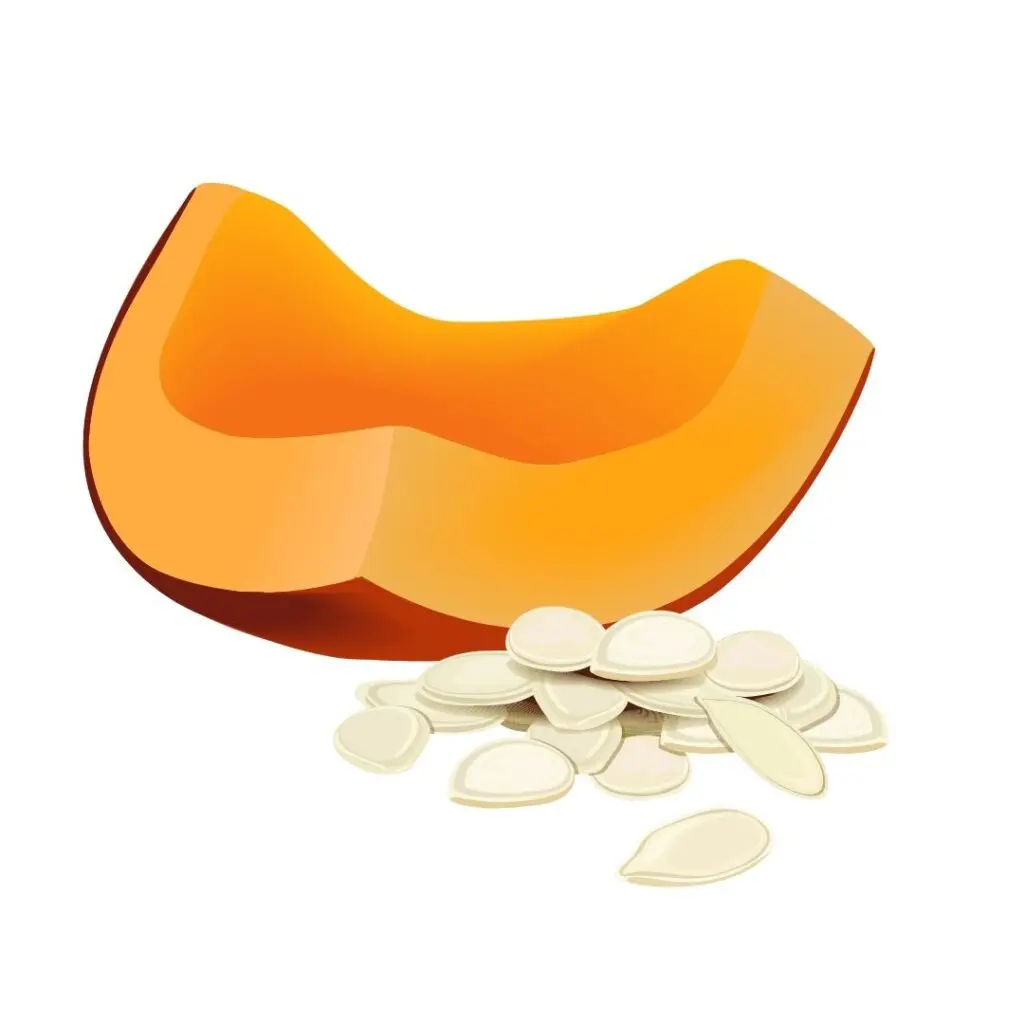
Sunflower Seeds
3mg oxalate per 1/4 cup
Sunflower seeds* are delicious on salads for a nutty flavor and crunch. Be careful to avoid salted and flavored sunflower seeds. Sunbutter* is made from sunflower seeds and is a tasty, lower oxalate alternative to peanut butter.
Watermelon Seeds
5mg oxalate per 1/4 cup
These can be harder to find, but watermelon seeds are another low oxalate seed.
High Oxalate Nuts & Seeds
On the flip side, there are some nuts and seeds that are very high in oxalate. If you have high urine oxalate, it is best to avoid these nuts and seeds. Or, eat them only on occasion!
- Almonds (122mg oxalate per ounce) – don’t forget almond butter, flour and milk are high in oxalate too!
- Brazil nuts (137mg oxalate per ounce)
- Cashews (49mg oxalate per ounce)
- Hazelnuts (63mg oxalate per ounce)
- Pine nuts (56mg oxalate per ounce)
- Chia seeds (45mg oxalate per 2 tablespoons)
- Sesame seeds (126mg oxalate per 2 tablespoons)
Advice for Eating Low Oxalate Nuts & Seeds
Watch Portion Size
Portion size is important to help control how much oxalate you eat. Even low oxalate nuts and seeds can add up!
A portion of nuts is 1 ounce, or about 1/4 cup of whole, shelled nuts. A portion of seeds is about 2 tablespoons for smaller seeds (like hemp or flax seeds), or a 1/4 cup for larger seeds (like sunflower or pumpkin seeds).
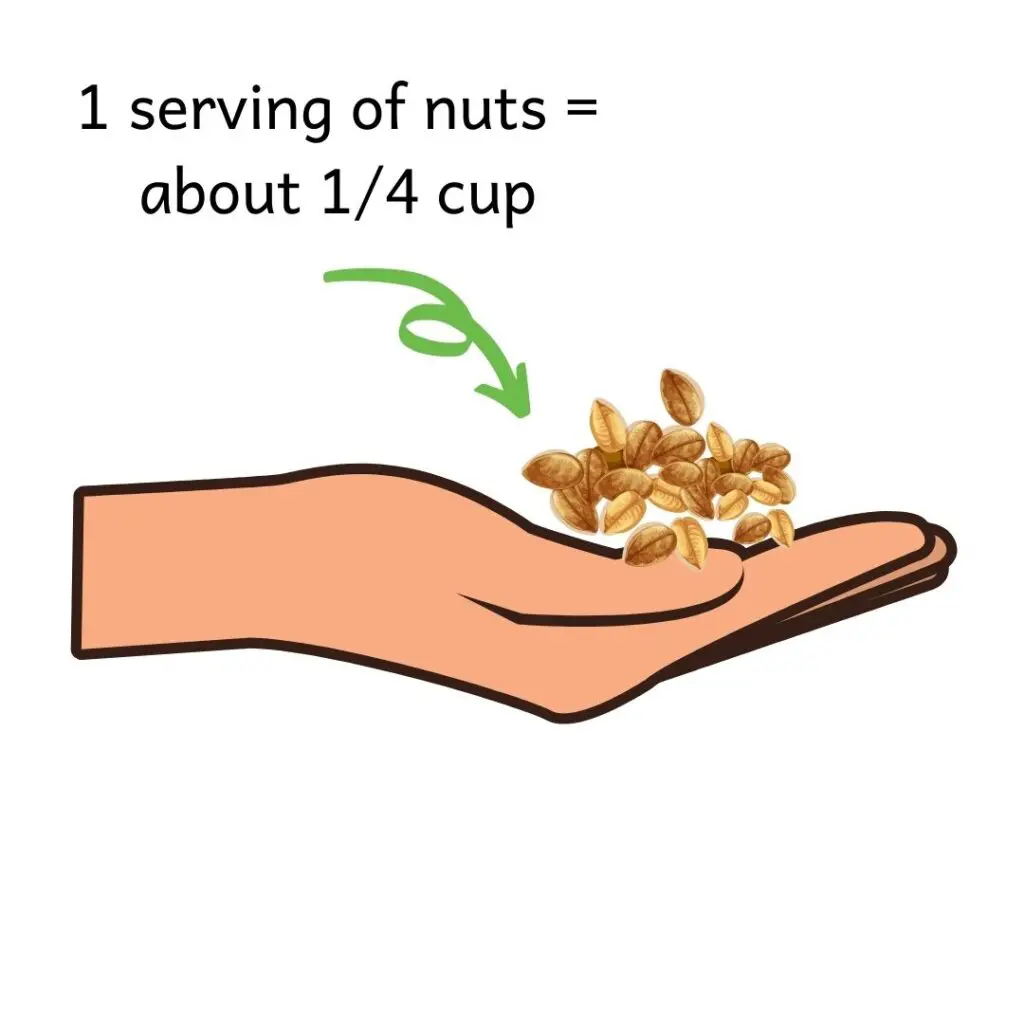
Choose Unsalted Low Oxalate Nuts!
Make sure to find unsalted or “lightly salted” nuts and seeds. Sodium plays a big role in kidney stones. Most people should limit sodium to 1,500-2,300mg per day to prevent kidney stones.
Happy Eating!
Melanie

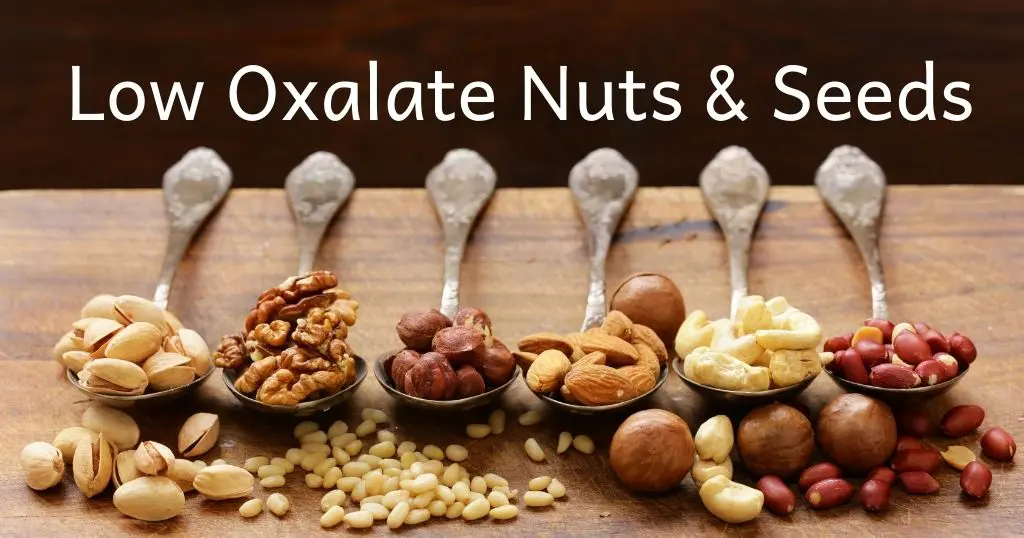
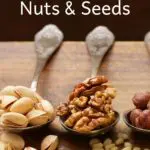
Hi, great list, thanks.
However one thing that would make it more useful is to be consistent with the units.
Additionally, switching from Tbsp (volume), and oz (weight), makes it difficult to compare.
EU standards are to use a 100 gram qty as a standard basis. While the serving size varies hugely for foods vs. spices, leave that determination up to the reader, rather than varying the sample size based on perceived serving size.
Thanks again for the info.
Hi Bruce! I’m glad this was helpful. I choose to use more user friendly portion sizes for people rather than the 100 gram standard portion since most people have NO idea what “100 grams” looks like. Pros and cons of both!
Although I do not have kidney stones, I have other health issues perhaps exacerbated by my previous largely vegan high oxalate food choices.
After reading Sally K. Norton’s “Toxic Superfoods” and now your material, I am perplexed about the differences and how to accurately reduce my oxalate intake to determine the effect. Any help appreciated.
Hi Jean! Thanks for sharing – I can imagine it is incredibly frustrating to be reading content from that world and my site. That book makes a ton of claims that are not supported by data. It takes incredibly small animal and/or cell studies about oxalate – and jumps to the conclusion that reducing or eliminating that molecule from our diet will improve all sorts of health conditions. The problem is, food and nutrition is SO much more complicated than that. You can’t JUST eliminate oxalate – when you reduce higher oxalate foods, you inevitably will also reduce MANY other nutrients that are so good for us. This is (one of the many reasons!) why we can’t take these types of studies and apply them to humans eating real food out in the real world living their real lives. This is both irresponsible and dangerous. So, although reducing some of the VERY high oxalate foods for SOME people might be important, oxalate is 100% ok for most of us.
I feel the same. Using consistent units would make it much easier however when it comes to oxalates the units are all over the place no matter where you look on the internet so I’m guessing the writer here gets the units from the same place everybody else gets them. I’ve decided to make my own calculations based on the weight of i.e. two tbs flax seeds.
Looking for Oxalate data from so-called MILKS made from seeds and nuts!
Here you go!
Amazing info!
As the recommended daily allowance of Brazil nuts are two a day, would the Oxalate content of just one be around 6 oxalates…?
As if you say 1 ounce of Brazil nuts has 137 oxalates – that’s around 18-22 nuts, so my (bad) math calculation says they have 6-7 Oxalate per 1 Brazil nut – which isn’t too high right?
Thanks 🙂
The amount of oxalate that is right for you COMPLETELY depends on your 24-hour urine test results – so I really can’t say what is ok or ideal for you!
Hi Han,
I try to eat two Brazil nuts every day. You are right that it isn’t a big source of oxalates to worry about.
I put some walnuts on my salads, and I also love sunflower and pumpkin seeds and pistachios.
Yours,
Ava
Seeing some snack foods coming out using the sacha inchi seed, which is being touted as particularly healthy and high in protein compared to other nuts. Any idea of the oxalate content on this one?
Unfortunately no idea!
How can I determine the oxalate content of a plant-derived powder product?
I called the manufacturer and they do not test for oxalates.
Please advise if there is a lab that can do this analysis.
Regards!
It would be virtually impossible to determine the exact oxalate content of foods like this. I don’t know of a reputable lab to recommend. This is one of the MANY reasons why I highly discourage specifically counting oxalate to avoid these stressors. I usually tell my students to check out the ingredients in a product to determine if it is high oxalate (only if oxalate is a concern for you, of course!).
Hey, Melanie, and thank you.
Raw sesame seeds, unhulled and both white and black, have been a part of my dozen or so raw seeds and nuts that I’ve eaten for decades. My sore foot tendons, etc. that led me to suspect too high of oxalates in my diet, necessitates some changes. I’ve read somewhere that the oxalates in sesame are mostly in the hulls, so if I switch to hulled ones am I “okay”? (I was unable to download the list from the email link you sent.)
Hello! You are so welcome. There is actually no research to suggest that eating higher oxalate foods could be an issue for sore tendons. I’d hate for you to unnecessarily restrict your diet!
Likely hulled sesame seeds are lower in oxalate than unhulled. But, I can’t be sure exactly how MUCH lower. My guess is there is still quite a bit of oxalate even in the hulled version.
Hello Melanie,
What study mentions Hemp Hearts as being low in Oxalate?
I get all of my oxalate information from either the Harvard list or a database commonly used in research called NSDR.
Thank you for the reply!
Great Article!
You mention 1/4 of a cup as a serving size for many nuts. What size cup is this, or what does it equate to in tablespoons?
Many thanks!
This is a standard cup measuring cup. Equivalent to 4 tablespoons.
Thank you Melanie. Let me get this correct.
1 Cup is equivalent to 4 Tablespoons?
Therefore 1/4 of a cup is 1 Tablespoon?
Or I am wrong and you are saying 1/4 of a cup = 4 Tablespoons?
Sorry for getting confused!
Abe
1 cup is 16 tablespoons. Therefore, a 1/4 cup is 4 tablespoons.
Many thanks!
There are good trans fats and virgin coconut oil is one of them. The American Heart Association is just plain wrong like the FDA is about it’s food pyramid. The FDA actually corrected itself that high cholesterol doesn’t cause heart disease.
We certainly learn more as science progresses. Changing the recommendation for cholesterol is one great example. Please provide a scientific reference that coconut oil (of any type) is beneficial for heart health.
There is also a need to provide a scientific reference if you are making the statement that coconut oil is bad for heart health. Not a report or opinion piece, but firm science.
Coconut oil is a majority saturated fat – and the best science we have says excess saturated fat is linked to poor heart health outcomes. There is no good data to suggest that the saturated fat in coconut oil is any different. As outlined in the guidelines from AHA which are backed by numerous peer-reviewed articles. I do not link to opinion pieces as references on my site.
Thanks for the response. I have no wish to argue for the sake of arguing. I just feel that science and doctrine have been confused by many. The AHA recommendations are opinion. Please have a look at the following 2 well-designed studies:
1) Ramsden CE, Zamora D, et al. 2013. Use of dietary linoleic acid for secondary prevention of coronary heart disease and death: Evaluation of recovered data from the Sydney Diet Heart Study and updated meta-analysis BMJ.
2) Frantz,ID, Dawson EA, et al. 1989. Test of effect of lipid lowering by diet on cardiovascular risk. The Minnesota Coronary Survey. Athersclerosis 9(1).
With these two studies, and others, the hypothesis that saturated fats and dietary cholesterol cause heart attacks and stroke has been tested in around 75,000 people. No controlled, scientific study has found a link. To the contrary, the above studies highlight concerns with polyunsaturated fats. I have no answers as to why the above studies have been ignored. They are well designed and the conclusions seem valid. With respect.
AHA guidelines are not based on opinion, but rather an extensive review of all literature available at the time. You can look to the studies referenced in the guidelines for specifics. As with all nutrition recommendations, you can find studies that find different results. Nutrition research is especially messy. This is why it is so important to look at ALL data available, and not just a handful of studies. These studies have not necessarily been ignored. Here is some data on LDL cholesterol and coconut oil specifically.
Cheryl. Coconut oil is NOT a trans fat. It is a saturated fat. A GOOD fat like meat fat. It does NOT raise cholesterol but the medium chain fatty acids in CO actually raised your HDL. My number actually doubled from 35 to 70 in 6 months, all my other CHO #s went down to double digit numbers except for Total which was 160.
Can you elaborate on what are other things people can do to prevent stones? I eat a greek yogurt with some almonds each day and do not know if this is causing my kidney stones. I think my biggest issue is that I do not drink much water. I have started to drink 34oz/per day in the last week. My stones range from 3-10mm. Would love to hear from you.
Hi there! Thanks so much for the comment. Nutrition for kidney stones is completely different for each person, depending on your 24-hour urine test results. There is truly no single “kidney stone diet”. You might be interested in this article, which expands more on the possible nutrition changes you could make for calcium oxalate kidney stones. If you want more help from me directly, definitely check out Kidney Stone Nutrition School!
Okay, so I was told and have read that consuming milk will be good for calcium and would not cause kidney stones. I drink about 6 to 8 oz. a day. I have had the 24 hour test twice in the past 5 years and was advised that I do not to be on oxalate diet. However, I have had and possibly have more stones both acid and calcium stones. My doctor said that is not that common. I take meds. for the acid stones and pot citra er 1,080 mg. twice a day. I consume 2 1/2 liters of water a day and 1 liter of tea, green tea and dandelion tea. no sugar and have lost 28 pounds in the last 18 months. Some chicken and fish , small amounts and one steak in that time . But I am not sure about the milk?
I can’t say what is best for you without reviewing your 24-hour urine test results! My guess is that milk would be a good thing for you, but I can’t say for sure. I help people figure these things out in Kidney Stone Nutrition School!
Melanie,
I just wanted to say thank you for putting all of this information together for those of us suffering from kidney stones. You’re an absolute hero to me for doing so. Thanks again!
You are so welcome! I’m so happy it was helpful for you!
Im trying to keep oxalates low to moderate…I would like to get some walnut butter to put on my apple as breakfast a few times a week. I see walnuts are the lowest in oxalates…a serving is 2 tbsp. How much oxalates would that translate to?
It is really impossible to know! This is why I don’t usually advocate for actually COUNTING oxalate. Instead, for people with high urine oxalate, I suggest simply avoiding those foods highest in oxalate and making sure to eat enough calcium. I’m sure that isn’t the answer you wanted to hear, but hopefully that actually makes things easier!
Thanks for the information Melanie – my doctor only gave me very vague advice so it’s a challenge finding reliable information.
Where do peanuts fit into this?
You are so welcome! You are definitely not alone in feeling lost. Peanuts are somewhere in the middle. Check out my complete oxalate list at my resources page! And please know that low oxalate diets are frequently prescribed inappropriately, without proper investigation into WHY you are forming stones. Here is an article to learn more!
You have walnuts listed as only having 8 mg of oxalates, but other sources claim it’s much higher. My urologist said they have 74 mgs of oxalates in 3.5 ounces.
There is a ton of misinformation out there about how much oxalate is in different foods – even from reputable sources. The Harvard list is largely considered to be one of the most accurate, which I base my information on whenever possible. You can find my list on my resources page.
Hi Melanie, I have 60% calcium oxalate mono hydrate; 20% calcium oxylate dihydrate and 20% calcium phosphate stones. I have not had a 24 hour urine analysis. I have the Harvard list of oxalates and I have been trying to be careful with that in selecting foods as well as trying to watch the sodium and sugar most of which is just in foods not because I add it. I had been using lite salt which is Salt and potassium chloride in my cooking. Now that I am reading, I don’t know that I should even use that! I have been drinking milk with each meal to try and get my calcium and to remove any oxalates that might slip in. I also have osteoporosis and when I went into the hospital with sepsis this summer, one of the doctors that was seeing me came in angry at me because I was taking a calcium supplement and vitamin D. I was just following doctors orders for my bone health. Now I have quit taking the calcium supplement and the vitamin D and I’m just drinking three glasses of milk a day but I am worried about my bone health and also the milk is going to put weight on me I think. Can you give any advice? I’ve been reading my head off trying to unravel all the confusion as there are many things that play into the building of these stones. When I was hungry and didn’t have time to eat I used to go grab a bag of chips… I have quit that. Salt Has always been more satisfying to me than sweet but I do realize I need to curtail that. Thanks for any help you can give!
Hi Connie! Thanks for the comment. I can’t give you advice without working more with you individually. I help people know exactly how to manage that calcium supplement kidney stone/osteoporosis conundrum and so much more in my course, Kidney Stone Nutrition School. I will say that milk will not necessarily change your body size. Also, I would really push for that 24 hour urine test. Without it, you (and your doctors!) are truly just guessing as to what will prevent more stones in the future. Here are some tips for asking your doctor for that test!
I have osteopenia and my endocrinologist told me not to take calcium supplements. I did learn that Vitamin D3 taken with Vitamin K2 helps bones. Take 100 mcg. of K2 per 1000 IU of D3. I wish one of my doctors had told me that years ago, I used to only take D3.
I may have missed it, but I don’t think so. Why is oatmeal not on the list? I have it most mornings.
Hi Janet! You can find my complete oxalate list at my resources page! Oatmeal is included.
Oatmeal is not listed, just Oat Bran. Very few people eat Oat brand — but plain old-fashioned rolled oats is an everyday healthy food — especially for those watching their weigh, concerned about cholesterol or heart health. I think it’s low oxalate, but didn’t see it listed.
In the same query, why is orange juice (a full cup) listed as low oxalate and an orange is listed as medium and borderline high. Doesn’t make sense. Also, every doctor and dietician recommends avoiding juice — to avoid fast glucose/sugar absorption. (Especially if watching weight, etc.
All types of oatmeal are on the lower oxalate side – in every database I’ve come across. Oranges are likely a bit higher in oxalate as they still contain more of the fiber-containing parts of the orange, which tend to contain oxalate. The list is not meant to be a list of foods I recommend, just simply stating the oxalate content of foods. I never recommend just “following” a list of foods. Instead, I recommend working with a dietitian to learn how to put together meals and snacks that work for YOU!
Do I understand correctly that it is the pith of an orange slice that contains oxylates so the juice is okay?
There is oxalate in both parts. But honestly, oxalate is the LEAST of my worries when it comes to stone prevention for the vast majority of people. Chances are, oranges are 100% ok for you to have.
Melanie,
I consume a daily amount of pecans, strawberries, organic cashews, grapes, pineapples and blueberries. I have kidney stones and have already had one removal procedure. I have now viewed several sites that suggest all these items are fine for my condition. But my doctor and others have shown me lists that say strawberries and cashews are bad. What’s the truth? Thanks.
The Harvard oxalate list is generally the gold standard for oxalate content. This is is the resource I use for all of my content. Unfortunately, there is a TON of oxalate misinformation, even from doctors offices floating around.
Hi Melanie, may I know where I can find the list? I searched “oxalate” on the HSPH’s website, but I could not find a list of oxalate content of foods.
Their list is hard to find – and I also don’t like to look at it directly because the portion sizes aren’t standardized (clearly they didn’t consult dietitians when making it!). I’ve taken that list, standardized the portion sizes and made it a bit more user friendly. You can find that on my resources page!
Wow! excited to know the facts-really ! one can have small doses of the right beans and nuts, not being deprived and reaping health benefits. Thanks so much ,Liz
I am confused because my doctor gave me a list of foods that says to avoid foods that have more than 10 mg of oxalate per serving. But then you’re saying low oxalate nuts are 14 mg per serving how is it that I can eat those Foods that you have listed? The only seed I am eating currently is pepitas which I found in reading an article about celiac disease and how similar a low oxalate diet is to a Celiac disease diet thought I was glad to see that I could eat pepitas.
There isn’t an official definition of a “low oxalate food”, so foods can easily come up differently on different lists. There is also a TON of incorrect oxalate information out there. I utilize the Harvard oxalate list, which is generally considered to be one of the most accurate. Hope that helps!
you talk about low oxalate diets for kidney stones but I am told that high oxylate foods are also bad for lichen sclerosis. can you comment on this relationship ?
There is little to no data to suggest a low oxalate diet helps lichen sclerosis.
Hi Melanie,
Thank you for this very informative website. I currently have calcium oxalate stones. I enjoy both black and white tahini. I heard that the oxalates content of sesame seeds are mainly in the form of insoluble calcium oxalate in the seed husk. If that’s the case, are hulled sesame seeds considered low-oxalate foods? Second, can insoluble calcium oxalate potentially cause urinary stones? I thought only soluble oxalates can contribute to calcium oxalate stones. Lastly, will boiling hazelnuts for 5 minutes before roasting turn these hazelnuts into low-oxalate ones?
Thank you.
Hi Bob! There is no official definition of a “low oxalate food”. So, I can’t really say if sesame seeds will contribute to kidney stones. The answer would also be completely different for each person. Most people with stones do not need to limit how much oxalate they eat. Technically, only the soluble oxalate would end up in urine – however, the research isn’t advanced enough for us to make this distinction. Boiling any food will reduce oxalate content somewhat, but it is difficult to know how much. Please know that healthy eating for calcium oxalate stones is MUCH more than oxalate. Oxalate is the least of my concerns for most people I work with I really hate for people to waste their time and energy stressing over oxalate this much!
Great info. However, If we don’t need to consider limiting oxalates to help reduce contribution to kidney stones, then why is this information even provided about high and low oxalate nuts and foods? And why do doctors tell people with chronic kidney stones to limit this intake?
Wonderful question! I provide this information because no matter HOW MUCH I scream from the top of the rooftops about how relatively unimportant oxalate is, people ask me unrelenting questions about low oxalate foods. So, I offer these articles and try to make it very clear in them that there are many other things you can do to prevent stones.
Unfortunately, many doctors do still recommend highly restrictive low oxalate diets, despite this lack of research and the guidelines to only recommend restricting oxalate for people with high urine oxalate on a 24 hour urine test. Old habits die hard. Another example of this is that I consistently get people telling me their doctor told them to limit calcium for calcium oxalate stones, despite the fact that this is INCREDIBLY outdated advice and is harmful for most calcium stone formers. Doctors mean well, but most doctors actually have NO nutrition training, which is where Registered Dietitians come in!